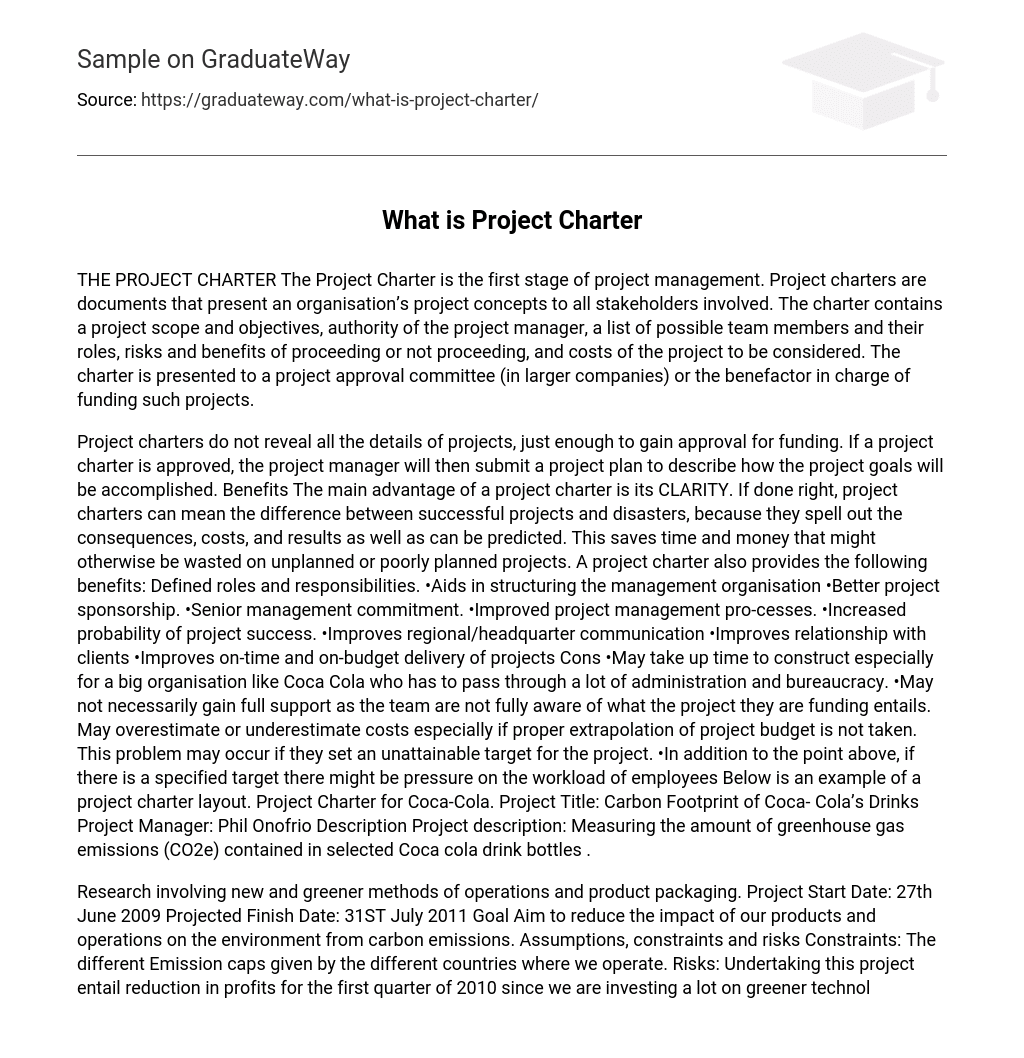THE PROJECT CHARTER The Project Charter is the first stage of project management. Project charters are documents that present an organisation’s project concepts to all stakeholders involved. The charter contains a project scope and objectives, authority of the project manager, a list of possible team members and their roles, risks and benefits of proceeding or not proceeding, and costs of the project to be considered. The charter is presented to a project approval committee (in larger companies) or the benefactor in charge of funding such projects.
Project charters do not reveal all the details of projects, just enough to gain approval for funding. If a project charter is approved, the project manager will then submit a project plan to describe how the project goals will be accomplished. Benefits The main advantage of a project charter is its CLARITY. If done right, project charters can mean the difference between successful projects and disasters, because they spell out the consequences, costs, and results as well as can be predicted. This saves time and money that might otherwise be wasted on unplanned or poorly planned projects. A project charter also provides the following benefits: Defined roles and responsibilities. •Aids in structuring the management organisation •Better project sponsorship. •Senior management commitment. •Improved project management pro-cesses. •Increased probability of project success. •Improves regional/headquarter communication •Improves relationship with clients •Improves on-time and on-budget delivery of projects Cons •May take up time to construct especially for a big organisation like Coca Cola who has to pass through a lot of administration and bureaucracy. •May not necessarily gain full support as the team are not fully aware of what the project they are funding entails. May overestimate or underestimate costs especially if proper extrapolation of project budget is not taken. This problem may occur if they set an unattainable target for the project. •In addition to the point above, if there is a specified target there might be pressure on the workload of employees Below is an example of a project charter layout. Project Charter for Coca-Cola. Project Title: Carbon Footprint of Coca- Cola’s Drinks Project Manager: Phil Onofrio Description Project description: Measuring the amount of greenhouse gas emissions (CO2e) contained in selected Coca cola drink bottles .
Research involving new and greener methods of operations and product packaging. Project Start Date: 27th June 2009 Projected Finish Date: 31ST July 2011 Goal Aim to reduce the impact of our products and operations on the environment from carbon emissions. Assumptions, constraints and risks Constraints: The different Emission caps given by the different countries where we operate. Risks: Undertaking this project entail reduction in profits for the first quarter of 2010 since we are investing a lot on greener technology matched with a slower rate of return in revenue. Resources
Financial: ? 300,000,000 Personnel: Lab Technicians Factory Workers Research analysts Public relations personnel Material: A Research Lab in Uxbridge, Great Britain Depots In different parts of Europe Approach •September 2010- The production and distribution of coca-cola cans with aluminum across Europe •May 2011- Experience a fall of 30% in our negative Impact on the environment Roles and Responsibilities NameRoleResponsibility John ThomasProject SponsorMonitor Project Dante SmithProject ManagerPlan and Execute Project Richard Truce Personnel ManagerOversee the various Departmental heads
Sign-off Jack Rousse, Managing Director J. Rousse Associates. 30th May 2009 SPONSPOR NAME, SPONSOR TITLEDate Phil Onofrio, R&D Manager, Coca Cola Enterprise. 30th May 2009 PROJECT MANAGER NAME, PROJECT MANAGER TITLEDate CASE STUDY: COCA-COLA Coca-Cola a prestigious beverage company has been having criticisms in the past decade. These are a few of the mishaps that they have been blamed for: •The Centre for Science and Environment claimed that Coca-Cola’s soft drinks contain cancer-causing chemicals. This led to an 11% drop in Indian Coca-cola sales. They were also criticized environmentally of over-usage of the local water in their areas of production. This action led to shortage of water for the regional farmers. •Packaging was not environmentally friendly. This may mean that Coca cola is not acting socially responsible and thus their corporate image is tarnished. To right their wrongs, they have to correct all that they have been criticized for. To become more organized with the change, they can draw out a project charter setting out the head of the project and the different roles and responsibilities.
This in turn sets out the strategies they plan to carry out and the cost if the strategies. The clarity of the project charter will help their stakeholders/shareholders to be able to fully understand what they plan to do and thus help to invest in the project. It may even help to show the critics that Coca-cola is truly serious about changing for the better. Since they are a widely-known company, this would have a huge positive impact on them- financially and ethically. REFERENCES •Bright Hub ‘What Is a Project Charter? ’ Article by Natasha Baker published November 2009. •thecoca-colacompany. com/presscenter/presskit. html





